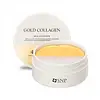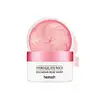What's inside
What's inside
 Key Ingredients
Key Ingredients

 Benefits
Benefits

 Concerns
Concerns

 Ingredients Side-by-side
Ingredients Side-by-side

Water
Skin ConditioningGlycerin
HumectantCalcium Chloride
AstringentCeratonia Siliqua Gum
EmollientXanthan Gum
EmulsifyingNiacinamide
SmoothingHydrolyzed Collagen
EmollientGlutathione
1,2-Hexanediol
Skin ConditioningHydroxyacetophenone
AntioxidantPentylene Glycol
Skin ConditioningChondrus Crispus Powder
AbrasivePEG-60 Hydrogenated Castor Oil
EmulsifyingSynthetic Fluorphlogopite
CI 77891
Cosmetic ColorantCI 77491
Cosmetic ColorantTin Oxide
AbrasiveEthylhexylglycerin
Skin ConditioningAdenosine
Skin ConditioningDisodium EDTA
Hydroxyethylcellulose
Emulsion StabilisingHibiscus Syriacus Bark Extract
Skin ConditioningAcetyl Hexapeptide-8
HumectantAcetyl Tetrapeptide-2
Skin ConditioningCopper Tripeptide-1
Skin ConditioningHexapeptide-9
Skin ConditioningNonapeptide-1
Skin ConditioningOligopeptide-29
AntioxidantPalmitoyl Pentapeptide-4
Skin ConditioningPalmitoyl Tetrapeptide-7
Skin ConditioningPalmitoyl Tripeptide-1
Skin ConditioningTripeptide-1
Skin ConditioningParfum
MaskingGold
Cosmetic ColorantHyaluronic Acid
HumectantHydrolyzed Hyaluronic Acid
HumectantSodium Hyaluronate
HumectantHydrolyzed Sodium Hyaluronate
Skin ConditioningPotassium Hyaluronate
Skin ConditioningSodium Acetylated Hyaluronate
HumectantHydroxypropyltrimonium Hyaluronate
Water, Glycerin, Calcium Chloride, Ceratonia Siliqua Gum, Xanthan Gum, Niacinamide, Hydrolyzed Collagen, Glutathione, 1,2-Hexanediol, Hydroxyacetophenone, Pentylene Glycol, Chondrus Crispus Powder, PEG-60 Hydrogenated Castor Oil, Synthetic Fluorphlogopite, CI 77891, CI 77491, Tin Oxide, Ethylhexylglycerin, Adenosine, Disodium EDTA, Hydroxyethylcellulose, Hibiscus Syriacus Bark Extract, Acetyl Hexapeptide-8, Acetyl Tetrapeptide-2, Copper Tripeptide-1, Hexapeptide-9, Nonapeptide-1, Oligopeptide-29, Palmitoyl Pentapeptide-4, Palmitoyl Tetrapeptide-7, Palmitoyl Tripeptide-1, Tripeptide-1, Parfum, Gold, Hyaluronic Acid, Hydrolyzed Hyaluronic Acid, Sodium Hyaluronate, Hydrolyzed Sodium Hyaluronate, Potassium Hyaluronate, Sodium Acetylated Hyaluronate, Hydroxypropyltrimonium Hyaluronate
Water
Skin ConditioningGlycerin
HumectantNiacinamide
SmoothingChondrus Crispus
MaskingButylene Glycol
HumectantCocos Nucifera Fruit Extract
EmollientPinus Sylvestris Leaf Extract
TonicPropanediol
SolventPentylene Glycol
Skin ConditioningRosa Damascena Flower Water
MaskingNelumbo Nucifera Flower Extract
Skin ConditioningPortulaca Oleracea Extract
Skin ConditioningHamamelis Virginiana Extract
AntiseborrhoeicCentella Asiatica Extract
CleansingEthylhexylglycerin
Skin ConditioningSodium Hyaluronate
HumectantDipotassium Glycyrrhizate
HumectantPEG-60 Hydrogenated Castor Oil
EmulsifyingCeratonia Siliqua Gum
EmollientSucrose
HumectantPotassium Chloride
Cyamopsis Tetragonoloba Gum
Emulsion StabilisingCalcium Chloride
AstringentAllantoin
Skin ConditioningTripropylene Glycol
AntioxidantDipropylene Glycol
HumectantCellulose Gum
Emulsion StabilisingChondrus Crispus Powder
AbrasiveRicinus Communis Seed Oil
MaskingCalcium Aluminum Borosilicate
Tin Oxide
AbrasiveCI 75470
Cosmetic ColorantCalcium Lactate
AstringentAdenosine
Skin ConditioningSynthetic Fluorphlogopite
Titanium Dioxide
Cosmetic ColorantDisodium EDTA
Ethyl Hexanediol
Solvent1,2-Hexanediol
Skin ConditioningChlorphenesin
AntimicrobialArginine
MaskingParfum
MaskingWater, Glycerin, Niacinamide, Chondrus Crispus, Butylene Glycol, Cocos Nucifera Fruit Extract, Pinus Sylvestris Leaf Extract, Propanediol, Pentylene Glycol, Rosa Damascena Flower Water, Nelumbo Nucifera Flower Extract, Portulaca Oleracea Extract, Hamamelis Virginiana Extract, Centella Asiatica Extract, Ethylhexylglycerin, Sodium Hyaluronate, Dipotassium Glycyrrhizate, PEG-60 Hydrogenated Castor Oil, Ceratonia Siliqua Gum, Sucrose, Potassium Chloride, Cyamopsis Tetragonoloba Gum, Calcium Chloride, Allantoin, Tripropylene Glycol, Dipropylene Glycol, Cellulose Gum, Chondrus Crispus Powder, Ricinus Communis Seed Oil, Calcium Aluminum Borosilicate, Tin Oxide, CI 75470, Calcium Lactate, Adenosine, Synthetic Fluorphlogopite, Titanium Dioxide, Disodium EDTA, Ethyl Hexanediol, 1,2-Hexanediol, Chlorphenesin, Arginine, Parfum
 Reviews
Reviews

Ingredients Explained
These ingredients are found in both products.
Ingredients higher up in an ingredient list are typically present in a larger amount.
1,2-Hexanediol is a synthetic liquid and another multi-functional powerhouse.
It is a:
- Humectant, drawing moisture into the skin
- Emollient, helping to soften skin
- Solvent, dispersing and stabilizing formulas
- Preservative booster, enhancing the antimicrobial activity of other preservatives
Adenosine is in every living organism. It is one of four components in nucleic acids that helps store our DNA.
Adenosine has many benefits when used. These benefits include hydrating the skin, smoothing skin, and reducing wrinkles. Once applied, adenosine increases collagen production. It also helps with improving firmness and tissue repair.
Studies have found adenosine may also help with wound healing.
In skincare products, Adenosine is usually derived from yeast.
Learn more about AdenosineCalcium chloride is a white, odorless, crystalline solid. It is an astringent and can be used to change the viscosity of products.
This ingredient is highly soluble in water, acetic acid, and ethanol.
There are many forms of this ingredient, including monohydrate, dihydrate, tetrahydrate, and hexahydrate.
Learn more about Calcium ChlorideCeratonia Siliqua Gum is extracted from the seeds of the carob tree. You might know this ingredient as Carob Gum or Locust Bean Gum. It is used to stabilize other ingredients and improve the texture of products.
Carob gum is made up of long-chain polysaccharides. This makes it a natural thickener.
Yes! This ingredient comes from the seeds of a tree. The name 'Locust Bean Gum' can be misleading.
Learn more about Ceratonia Siliqua GumChondrus Crispus Powder is an exfoliant.
Disodium EDTA plays a role in making products more stable by aiding other preservatives.
It is a chelating agent, meaning it neutralizes metal ions that may be found in a product.
Disodium EDTA is a salt of edetic acid and is found to be safe in cosmetic ingredients.
Learn more about Disodium EDTAEthylhexylglycerin (we can't pronounce this either) is commonly used as a preservative and skin softener. It is derived from glyceryl.
You might see Ethylhexylglycerin often paired with other preservatives such as phenoxyethanol. Ethylhexylglycerin has been found to increase the effectiveness of these other preservatives.
Glycerin is already naturally found in your skin. It helps moisturize and protect your skin.
A study from 2016 found glycerin to be more effective as a humectant than AHAs and hyaluronic acid.
As a humectant, it helps the skin stay hydrated by pulling moisture to your skin. The low molecular weight of glycerin allows it to pull moisture into the deeper layers of your skin.
Hydrated skin improves your skin barrier; Your skin barrier helps protect against irritants and bacteria.
Glycerin has also been found to have antimicrobial and antiviral properties. Due to these properties, glycerin is often used in wound and burn treatments.
In cosmetics, glycerin is usually derived from plants such as soybean or palm. However, it can also be sourced from animals, such as tallow or animal fat.
This ingredient is organic, colorless, odorless, and non-toxic.
Glycerin is the name for this ingredient in American English. British English uses Glycerol/Glycerine.
Learn more about GlycerinNiacinamide is a multitasking form of vitamin B3 that strengthens the skin barrier, reduces pores and dark spots, regulates oil, and improves signs of aging.
And the best part? It's gentle and well-tolerated by most skin types, including sensitive and reactive skin.
You might have heard of "niacin flush", or the reddening of skin that causes itchiness. Niacinamide has not been found to cause this.
In very rare cases, some individuals may not be able to tolerate niacinamide at all or experience an allergic reaction to it.
If you are experiencing flaking, irritation, and dryness with this ingredient, be sure to double check all your products as this ingredient can be found in all categories of skincare.
When incorporating niacinamide into your routine, look out for concentration amounts. Typically, 5% niacinamide provides benefits such as fading dark spots. However, if you have sensitive skin, it is better to begin with a smaller concentration.
When you apply niacinamide to your skin, your body converts it into nicotinamide adenine dinucleotide (NAD). NAD is an essential coenzyme that is already found in your cells as "fuel" and powers countless biological processes.
In your skin, NAD helps repair cell damage, produce new healthy cells, support collagen production, strengthen the skin barrier, and fight environmental stressors (like UV and pollution).
Our natural NAD levels start to decline with age, leading to slower skin repair, visible aging, and a weaker skin barrier. By providing your skin niacinamide, you're recharging your skin's NAD levels. This leads to stronger, healthier, and younger looking skin.
Another name for vitamin B3 is nicotinamide. This vitamin is water-soluble and our bodies don't store it. We obtain Vitamin B3 from either food or skincare. Meat, fish, wheat, yeast, and leafy greens contain vitamin B3.
The type of niacinamide used in skincare is synthetically created.
Learn more about NiacinamideParfum is a catch-all term for an ingredient or more that is used to give a scent to products.
Also called "fragrance", this ingredient can be a blend of hundreds of chemicals or plant oils. This means every product with "fragrance" or "parfum" in the ingredients list is a different mixture.
For instance, Habanolide is a proprietary trade name for a specific aroma chemical. When used as a fragrance ingredient in cosmetics, most aroma chemicals fall under the broad labeling category of “FRAGRANCE” or “PARFUM” according to EU and US regulations.
The term 'parfum' or 'fragrance' is not regulated in many countries. In many cases, it is up to the brand to define this term.
For instance, many brands choose to label themselves as "fragrance-free" because they are not using synthetic fragrances. However, their products may still contain ingredients such as essential oils that are considered a fragrance by INCI standards.
One example is Calendula flower extract. Calendula is an essential oil that still imparts a scent or 'fragrance'.
Depending on the blend, the ingredients in the mixture can cause allergies and sensitivities on the skin. Some ingredients that are known EU allergens include linalool and citronellol.
Parfum can also be used to mask or cover an unpleasant scent.
The bottom line is: not all fragrances/parfum/ingredients are created equally. If you are worried about fragrances, we recommend taking a closer look at an ingredient. And of course, we always recommend speaking with a professional.
Learn more about ParfumPeg-60 Hydrogenated Castor Oil comes from hydrogenated castor oil. It is a solubilizer and emulsifier.
As a solubilizer, it helps dissolve ingredients into a water-based version. It is also an emulsifer. Emulsifier help prevent oils and water from separating. Both these properties help create evenly-spread and uniform products.
Basically, Peg-60 Hydrogenated Castor Oil helps hold ingredients together.
Learn more about PEG-60 Hydrogenated Castor OilPentylene glycol is typically used within a product to thicken it. It also adds a smooth, soft, and moisturizing feel to the product. It is naturally found in plants such as sugar beets.
The hydrophilic trait of Pentylene Glycol makes it a humectant. As a humectant, Pentylene Glycol helps draw moisture from the air to your skin. This can help keep your skin hydrated.
This property also makes Pentylene Glycol a great texture enhancer. It can also help thicken or stabilize a product.
Pentylene Glycol also acts as a mild preservative and helps to keep a product microbe-free.
Some people may experience mild eye and skin irritation from Pentylene Glycol. We always recommend speaking with a professional about using this ingredient in your routine.
Pentylene Glycol has a low molecular weight and is part of the 1,2-glycol family.
Learn more about Pentylene GlycolSodium Hyaluronate is hyaluronic acid's salt form. It is commonly derived from the sodium salt of hyaluronic acid.
Like hyaluronic acid, it is great at holding water and acts as a humectant. This makes it a great skin hydrating ingredient.
Sodium Hyaluronate is naturally occurring in our bodies and is mostly found in eye fluid and joints.
These are some other common types of Hyaluronic Acid:
Learn more about Sodium HyaluronateSynthetic Fluorphlogopite is the synthethic version of mica. It consists of fluorine, aluminum and silicate.
Synthetic Fluorphlogopite is used to add volume to products.
It is considered non-irritating on the skin.
Learn more about Synthetic FluorphlogopiteTin Oxide is an inorganic oxide used to add opacity and volume to a product. In nature, it is already found in mineral form. The main ore of tin is an opaque and shiny mineral called casseterite.
Tin Oxide helps remove translucency in a product, or make it more opaque. Besides adding opacity, tin oxide is used for bulking to add volume.
Water. It's the most common cosmetic ingredient of all. You'll usually see it at the top of ingredient lists, meaning that it makes up the largest part of the product.
So why is it so popular? Water most often acts as a solvent - this means that it helps dissolve other ingredients into the formulation.
You'll also recognize water as that liquid we all need to stay alive. If you see this, drink a glass of water. Stay hydrated!
Learn more about Water